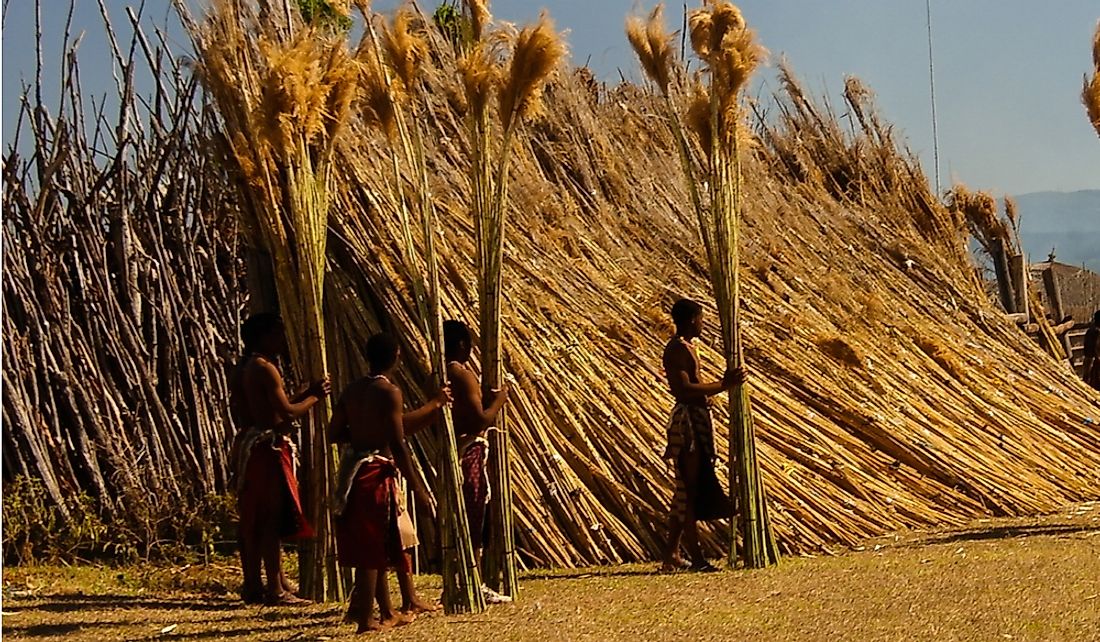The Culture Of Eswatini

Eswatini, previously known as Swaziland, is a Southern African country. The country has a unique and interesting culture that is based on traditional African beliefs and reflects some influences of British culture due to the former British colonial rule in the country.
6. Ethnicity, Language, and Religion in Eswatini
Eswatini is home to around 1,087,200 individuals. The population is ethnically quite homogeneous with most of the residents being indigenous Swazi. A small Zulu and White population also exists in the country. Both English and siSwati are the official languages of the country. 90% of Eswatini’s population adheres to Christianity of which around 40% practice a form of syncretic religion that blends Christianity and indigenous ancestral worship. 20% are Catholic Christians. The remaining Christians are affiliated to other Christian denominations.
5. Cuisine of Eswatini
The cuisine of the country varies geographically and seasonally. Maize and sorghum are the staples of the diet. Most widely consumed dishes include Emasi emabele (ground sorghum and sour milk) and Sidvudvu (pumpkin and cornmeal porridge). These are usually served with goat meat, the most popular meat in the country. Goat meat and beef are also exported from Eswatini. Food crops like sugar cane, peanuts, rice, and corn are also grown. Most of the farmers in Eswatini are subsistence farmers who often need to supplement their diet with food bought from the markets. Dried uncooked meat called biltong is considered a delicacy.
4. Literature and the Arts in Eswatini
Written literature in Eswatini developed much later. The country, however, has a rich tradition of oral literature with a long history. During the colonial era, the spread of formal education gave birth to many writers who wrote about the country and its culture in English and later in the siSwati language. Today, the country’s writers publish works covering a diversity of themes ranging from history to social issues, politics, and more.
Eswatini also has a rich art and craft scene. Bead jewelry and beaded clothing accessories from the country are well-known. Clay pots called tindziwo and wooden sculptures are produced by the country’s craftsmen. Swazis also make many items from special grasses like grass mats, baskets, brooms, etc.
3. Performance Arts in Eswatini
Eswatini has a varied music and dance scene. Both traditional and folk music as well as modern genres like hip hop, pop, and rock are popular in the country. Many cultural festivals are held in Eswatini like Umhlanga and Incwala. During Umhlanga, Swazi women perform a traditional dance and participate in reed-cutting ceremonies. They present the reed to the Queen mother. Musical instruments like rattles, reed flute, calabash, kudu horn, etc., are used to play music during such ceremonies. The Incwala ceremony is a harvest ceremony where the King tastes the new harvest. While the public participates in the ceremony, they cannot do so without the involvement of the King. No person can hold Incwala without the King as doing so will lead to high treason.
2. Sports in Eswatini
Football is the most popular sport in Eswatini. It is played both professionally and informally by the Swazis. The country also has a national football team that participates in international matches. A Premier League held within the country attracts a large number of spectators. Other games and outdoor activities like basketball, tennis, fishing, swimming, etc., are also enjoyed by the Swazis.
1. Life in the Swazi Society
The society in Eswatini is patriarchal in nature. Men and women are assigned traditional gender-based roles. Women are expected to manage the household and rear children while men are regarded as the head of their families and the primary breadwinners. In rural areas, women participate in many agricultural activities, especially gardening and cash crop cultivation. Men herd cattle and plow fields and carry out other labor-intensive activities. Finances are mainly controlled by men. In urban areas, few women work outside their homes. Those women who are employed usually have lower positions and wages than men.
Marriages in Eswatini are mostly arranged although "love marriages" are on the rise. Men pay a bride price in the form of livestock, clothes, or money to the bride’s family in exchange for their daughter. Polygamous marriages were quite common in the past. Today, Christian teachings and the economy of keeping multiple wives have discouraged most Swazi men from marrying more than once. Children are considered an essential part of most marriages and boys are valued more than girls in many families. Divorces are rare but increasing, especially in urban areas. Marriages within the same clan are strictly prohibited.
Household size in Eswatini ranges from nuclear in the urban areas to extended in the rural areas. In extended households, a man lives with his wives, married sons and their families, and unmarried daughters. In households with multiple wives, each wife is usually provided with a separate dwelling within the same complex. Occasionally, other relatives might also stay in the household. Only male children inherit the property of their father.
The entire community participates in the upbringing of children. In rural areas, boys and girls start assisting their parents in their work at an early age. Almost every child receives primary education but about half of the children drop out during secondary education.
The Swazi people value hospitality. A guest to a Swazi home is always offered food and rest. These people also greatly respect their elders. The words of the elders are regarded as wise. They greet each other extensively and ask about health and well-being.







